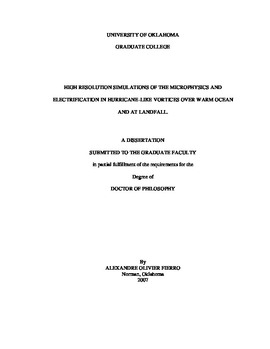| dc.contributor.advisor | Leslie, Lance, | en_US |
| dc.contributor.author | Fierro, Alexandre Olivier. | en_US |
| dc.date.accessioned | 2013-08-16T12:20:57Z | |
| dc.date.available | 2013-08-16T12:20:57Z | |
| dc.date.issued | 2007 | en_US |
| dc.identifier.uri | https://hdl.handle.net/11244/1279 | |
| dc.description.abstract | Cloud-to-ground (CG) lightning bursts in the eyewall of mature tropical cyclones (TCs) are believed to be good indicators of imminent intensification of these systems. While numerous well-documented observational cases exist in the literature, no modeling studies of the electrification processes within TCs have been made so far. At present, little is known about the evolution of charges and subsequent electrification in mature TCs. Towards this goal, a numerical cloud model featuring a 12-class bulk microphysics scheme and a three-dimensional branched lightning module is utilized to simulate the evolution of the microphysics fields and subsequent electrical activity in an idealized hurricane like vortex over ocean (OCEAN case). In a separate experiment (LAND case), two simulations were carried out a slightly coarser resolution. The first simulation was similar than the OCEAN case, while in the second simulation, a simplistic landmass was introduced in the domain in order to investigate the effect of reduced sensible and moisture flux and enhanced drag on the TC's dynamics, microphysics and electrification. | en_US |
| dc.description.abstract | Preliminary results of the OCEAN TC case showed that the highest total lightning flash rate were primarily found within the eyewall but seldom within the stronger cells forming the outer rainbands where updraft speeds rarely exceeded 10 m s-1 and 15 m s-1, respectively, consistent with observations. As expected, these regions of the storm were generally characterized by moderate total graupel mixing ratio (> 0.5 g kg -1) and moderate cloud water content (> 0.2 g kg-1). Using the Saunders and Peck non-inductive (NI) charging scheme and moderate inductive charging settings, the inner eyewall region exhibited a normal tripole charge structure (a mid-level negative charge layer amidst two positive charges regions) while a normal dipole (a positive charge region atop a negative charge region at mid-levels) was observed in the outer eyewall stratiform region and in the strongest cells forming the outer rainbands. The charges forming the normal dipole in the outer eyewall were generated within the eyewall via NI charging in the mixed-phase region at mid-levels (near the -15° C isotherm). | en_US |
| dc.description.abstract | In summary, despite producing quantitatively different results, the qualitative aspects of the simulated squall line dynamics, microphysics and lightning were overall similar. This suggested that the hurricane simulations presented in this study could still provide a good and useful qualitative insight of the storm's dynamical, microphysical and electrical properties. | en_US |
| dc.description.abstract | The simulated tropical squall line exhibited many features consistent with observations. In particular, the updraft speeds were generally much weaker than their continental counterparts, which was in turn consistent with relatively shallow 30 dBZ echo tops and lower content of graupel and supercooled water droplets within the mixed phase layer. This general reduction of graupel and supercooled water was partly caused by a rapid depletion of liquid water by enhanced warm rain processes ahead of the line, in agreement with previous studies. The stratiform region was almost exclusively composed of light ice crystals and snow aggregates, with discrete regions, however, containing small amounts of graupel (∼ 0.1-0.3 g kg-1) All of these factors combined resulted in a system producing overall little lightning. | en_US |
| dc.description.abstract | In the LAND TC experiment the landfalling storm was, as expected, much weaker (higher surface pressure, weaker winds) and less organized than the storm evolving over ocean. The weaker landfalling storm was associated with smaller eyewall total updraft mass flux and shallower echo tops (particularly 30 dBZ and greater) in turn consistent with smaller total graupel volume aloft and an overall smaller total lightning activity. Perhaps the most interesting finding of the LAND experiment was that several +CG flashes were produced after landfall, which was not observed in the control simulation over ocean. This indicated that, as suggested by observations, there exists a qualitative difference in the storm electrical behavior after landfall, which as we showed, was directly linked to its change in kinematical and microphysical fields. Observational studies, however, showed that this difference in lightning behavior over land versus over ocean varied from case to case, and therefore could not be generalized. (Abstract shortened by UMI.) | en_US |
| dc.description.abstract | Before carrying out these experiments, however, it was necessary to test the reliability of the model in maritime tropical environment. For this purpose, an additional idealized high-resolution simulation of a well-documented TOGA COARE squall line case was carried out. Moreover, for a single microphysical and electrical evolution, the latter experiment was carried out at three additional horizontal grid spacings to determine how the storm's dynamical, microphysical and electrical properties responded to these changes. | en_US |
| dc.format.extent | xxi, 260 leaves : | en_US |
| dc.subject | Lightning. | en_US |
| dc.subject | Atmospheric Sciences. | en_US |
| dc.subject | Microphysics. | en_US |
| dc.subject | Cyclones Tropics. | en_US |
| dc.subject | Convection (Meteorology) | en_US |
| dc.title | High resolution simulations of the microphysics and electrification in hurricane-like vortices over warm ocean and at landfall. | en_US |
| dc.type | Thesis | en_US |
| dc.thesis.degree | Ph.D. | en_US |
| dc.thesis.degreeDiscipline | School of Meteorology | en_US |
| dc.note | Adviser: Lance Leslie. | en_US |
| dc.note | Source: Dissertation Abstracts International, Volume: 68-12, Section: B, page: 7869. | en_US |
| ou.identifier | (UMI)AAI3291238 | en_US |
| ou.group | College of Atmospheric & Geographic Sciences::School of Meteorology | |
